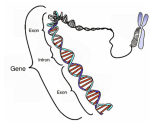Maybe I’m obsessing over a tiny bit of language here, but I really believe that the language we use has a large impact on the way we think about things, and thus, the way we go about solving problems. Take the concept of “gene” for example.
Everything I’ve leaned about genetics tells me that there is no clear obvious separation of genes and environment. It’s like the boundary of the Mandelbrot Set.
 If you try to untangle the source of something to determine whether it is from genes or environment (nature vs. nurture), you usually fail. And that’s because the interactions of genes with the environment is really like the boundary of the Mandelbrot Set. You can keep zooming in, but you’ll never find the boundary.
If you try to untangle the source of something to determine whether it is from genes or environment (nature vs. nurture), you usually fail. And that’s because the interactions of genes with the environment is really like the boundary of the Mandelbrot Set. You can keep zooming in, but you’ll never find the boundary.
And this is fundamental to how nature operates.
Both Environment and Genetic Makeup Influence Behavior
From Wikipedia:
it is rarely productive to talk about a “gene” in the singular. “Genes” is almost always a plural concept. And the reason is because the interaction of genes and environment (the fundamental basis for evolution) goes all the way down to the level of the genes themselves. In other words:
At a Basic Level: Genes are the environment for genes.
The way a gene is expressed is influenced by the other genes who take part in the choreography of expression.
I originally learned this from reading Richard Dawkins’ The Selfish Gene. From the point of view of the single gene, being the most atomic unit of selection, EVERYTHING other than itself…constitutes the environment. That includes other genes.
So, when you hear a science writer claiming that “Researchers determine that there is no ‘math gene’…”, you should conclude that the author is (1) correct, and (2) ignorant about biology.
Of course there is no math gene. Math skill (or any skill) grows out of a tangled interaction of inherited instinct (genetic makeup) and environmental factors (experience, learning, outside influences). The “nature vs. nurture” debate is counter-productive. The question should not be about determining which is the cause. It should be about determining the way these two factors come together to continually bring the natural world into being.
Because it’s a tangled hierarchy of influences, people get uncomfortable. Science is supposed to untangle these things, right? Not always. Science can help us understand that tangled hierarchies are actually the norm. That’s nature.
This is not to say that there are no culprit genes for certain diseases or observable traits. They do in fact exist in certain cases. For instance: there do exist “single gene disorders“. But these are usually mutations – deviations of an otherwise natural situation.
John Oliver recently made a compelling rant against science journalism, and how perfectly valid science often gets trivialized, simplified, and even rendered false…for mass consumption.
There is no single bullet theory in nature. Science writers should spend less time looking for a simple story to catch people’s eye with a punchy headline. Nature is complex…like the Mandelbrot Set. And that’s awesome.








 I think we should be working to fix our own emotional mess, instead of trying to make vague, naive predictions about machines having feelings. Machines will – eventually – have something analogous to animal motivation and human states of mind, but by then the human world will look so different that the current conversation will be laughable.
I think we should be working to fix our own emotional mess, instead of trying to make vague, naive predictions about machines having feelings. Machines will – eventually – have something analogous to animal motivation and human states of mind, but by then the human world will look so different that the current conversation will be laughable.  This article
This article